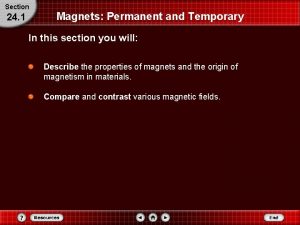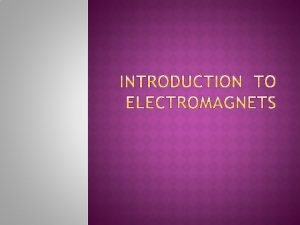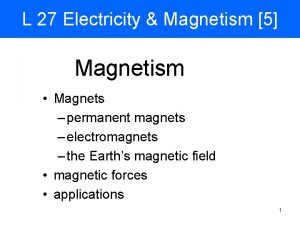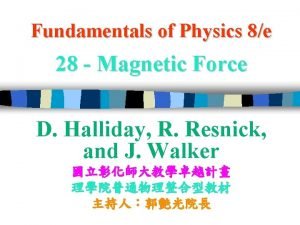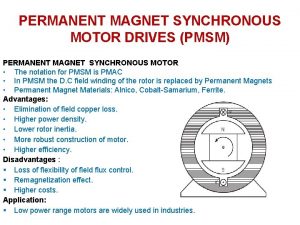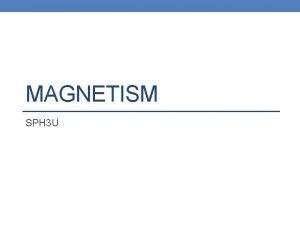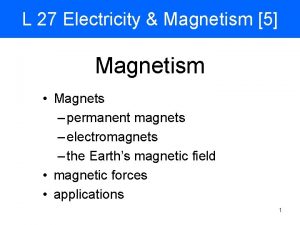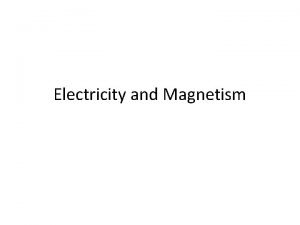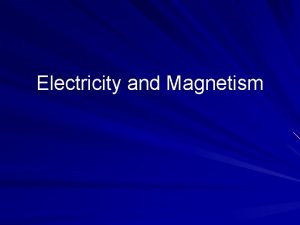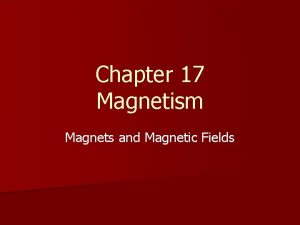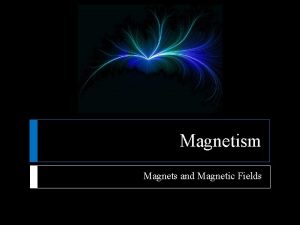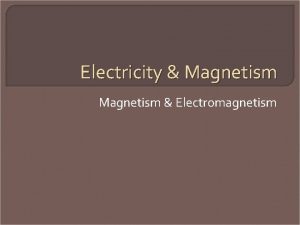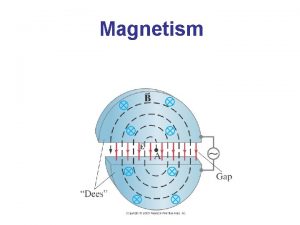Magnetism Types of Magnets Permanent Magnets magnetic once












- Slides: 12

Magnetism

Types of Magnets �Permanent Magnets (magnetic once magnetized) Ferromagnetism � Neodymium Iron Boron (Nd. Fe. B or NIB) � Samarium Cobalt (Sm. Co) � Alnico � Ceramic or Ferrite (Iron, Cobalt, Nickel) �Temporary Magnets – induced from magnetic field Diamagnetism – found in all matter (very small) Paramagnetism – stronger than diamagnetism (unpaired e-) �Electromagnets

Properties of Magnets �Magnets have two opposite poles. north south �Magnets exert forces on each other. Like poles repel Unlike poles attract. �The forces depend on the alignment of the poles.

The force between two magnets �The strength of the force between magnets depends on the distance between them. �The magnetic force decreases with distance much faster than does either gravity or the electric force.

Magnetic Fields �All magnets create a magnetic field in the space around them, and the magnetic field creates forces on other magnets. �The closer the lines are together, the stronger the field. �Magnetic field lines always point away from a magnet’s north pole and toward its south pole.

Earth’s Magnetic Field �Moving molten iron and in nickel Earth’s outer core causes most of Earth’s magnetic field. �Field has direction: lines point away from N and toward S. �Poles have switched in the past.

Cause of Magnetism �Magnetic fields are produced by moving electric charges. � There are two ways in which electrons create magnetism: 1. 2. Electrons around the nucleus and their motion makes the entire atom a small magnet. Electrons themselves act as though they were magnets. �In most materials, electron spin contributes more to magnetism than electron orbital motion. �Electrons are (very) tiny magnets.

Cause of Magnetism �Electrons with opposite spins (paired e-) cancel each other’s magnetic fields. �Electrons with spins aligned (unpaired e-) strengthen each other’s magnetic fields. �unpaired electrons can give the atoms an overall magnetic field.

Magnetic Domains �Atoms with similar magnetic orientations line up with neighboring atoms in groups called magnetic domains. �All of the domains of a magnetic substance tend to align themselves in the same direction when placed in a magnetic field.

Electricity and Magnetism �When an electric current passes through a wire a magnetic field is formed. Right hand rule – wrap in direction of magnetic field, thumbs points to magnetic north

Electromagnet �When an electric current is passed through a coil of wire wrapped around a metal core, a very strong magnetic field is produced. This is called an electromagnet.

Electromagnets �Changing the strength of an electromagnet Change the voltage Change the number of loops
 What happens when you break a magnet in half
What happens when you break a magnet in half Permanent and temporary magnet
Permanent and temporary magnet What are magnets made of
What are magnets made of Scrapyard crane diagram
Scrapyard crane diagram Chapter 24 magnetism magnetic fundamentals answers
Chapter 24 magnetism magnetic fundamentals answers Magnets and magnetic fields lesson 1 answer key
Magnets and magnetic fields lesson 1 answer key Confidential
Confidential Magnetic field strength h
Magnetic field strength h Magnetic moment and magnetic field relation
Magnetic moment and magnetic field relation F=i(lxb)
F=i(lxb) Types of magnetism
Types of magnetism What is permanent joint?
What is permanent joint? Pmsm torque equation
Pmsm torque equation
